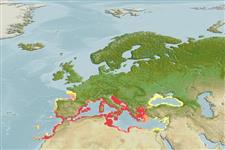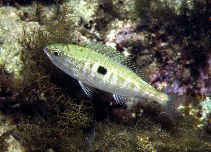Waarneming toevoegen in Fish Watcher
| Native range | All suitable habitat | Point map | Year 2050 |

|
| This map was computer-generated and has not yet been reviewed. |
| Spicara maena AquaMaps Data sources: GBIF OBIS |
Uploaden van uw Foto's en video's
Pictures | Videos | Google afbeeldingSpicara maena
Picture by Patzner, R.
Pictures | Videos | Google afbeeldingSpicara maena
Picture by Patzner, R.
Croatia country information
Common names:
Cipavica, Gavorica, Gira oštrulja
Occurrence: native
Salinity: marine
Abundance: | Ref:
Importance: | Ref:
Aquaculture: | Ref:
Regulations: | Ref:
Uses: no uses
Comments: Species maena and flexuosa observed to have some difference, with the former more blue and can grow bigger, it spawns in September on poseidonia and observed to be fighthing for mates; the latter spawns in winter at depts of 30 -50 meters on different bottom (lignja@submania.hr, pers. comm. 09/2006).
National Checklist:
Country Information: https://www.cia.gov/library/publications/resources/the-world-factbook/geos/hr.html
National Fisheries Authority:
Occurrences: Occurrences Point map
Main Ref: Bauchot, M.-L., 1987
National Database:
Occurrence: native
Salinity: marine
Abundance: | Ref:
Importance: | Ref:
Aquaculture: | Ref:
Regulations: | Ref:
Uses: no uses
Comments: Species maena and flexuosa observed to have some difference, with the former more blue and can grow bigger, it spawns in September on poseidonia and observed to be fighthing for mates; the latter spawns in winter at depts of 30 -50 meters on different bottom (lignja@submania.hr, pers. comm. 09/2006).
National Checklist:
Country Information: https://www.cia.gov/library/publications/resources/the-world-factbook/geos/hr.html
National Fisheries Authority:
Occurrences: Occurrences Point map
Main Ref: Bauchot, M.-L., 1987
National Database:
Common names from other countries
Classificatie / Names Lokale namen | Synoniemen | Catalog of Fishes(Genus, Soort(en)) | ITIS | CoL | WoRMS | Cloffa
> Eupercaria/misc (Various families in series Eupercaria) > Sparidae (Porgies)
Etymology: Spicara: Latin, spicare = furnished with spike (Ref. 45335).
More on author: Linnaeus.
Etymology: Spicara: Latin, spicare = furnished with spike (Ref. 45335).
More on author: Linnaeus.
Issue
Spicara flexuosa Rafinesque, 1810 is a valid species (Ref. 124120). Species page to be created.
Environment: milieu / climate zone / depth range / distribution range Ecologie
marien; diepte 30 - 130 m (Ref. 7349). Subtropical; 47°N - 28°N, 19°W - 42°E
Verspreiding Landen | FAO regio's | Ecosystemen | Voorkomen | Point map | Introducties | Faunafri
Eastern Atlantic: Portugal, Morocco, and Canary Islands including the Mediterranean and Black Sea.
Lengte bij maturiteit / Grootte / Gewicht / Leeftijd
Maturity: Lm 11.5 range ? - ? cm
Max length : 25.0 cm SL mannelijk / geslacht onbekend; (Ref. 6518); 21.0 cm SL (female); max. gepubliceerd gewicht: 160.00 g (Ref. 131232)
Max length : 25.0 cm SL mannelijk / geslacht onbekend; (Ref. 6518); 21.0 cm SL (female); max. gepubliceerd gewicht: 160.00 g (Ref. 131232)
Adults are found in the neritic zone, commonly over Posidonia beds and on sand, muddy and rock bottoms down to about 100 m (Ref. 6518, 124120). They are distributed at depths of 30m to 90m (Ref. 56124). Feed on zooplankton. Are protogynous hermaphrodites. A demersal spawner (Ref. 124120).
Levenscyclus en paargedrag Maturiteit | Voortplanting | Paaien | Eieren | Fecunditeit | Larven
Sex reversal occurs at lengths over 10.9 cm TL in the northeastern Mediterranean (Ref. 93202). Also Ref. 103751.
Hoofdreferentie
Upload your references | Referenties | Coördinator | Medewerkers
Heemstra, P.C., 1990. Centracanthidae. p. 768-772. In J.C. Quero, J.C. Hureau, C. Karrer, A. Post and L. Saldanha (eds.) Check-list of the fishes of the eastern tropical Atlantic (CLOFETA). JNICT, Lisbon; SEI, Paris; and UNESCO, Paris. Vol. 2. (Ref. 7349)
Status op de Rode Lijst van het IUCN (Ref. 130435: Version 2024-2)
Niet bedreigd (LC) ; Date assessed: 22 August 2009
Gevaar voor de mens
Harmless
Gebruik door de mens
Visserij: van minder commercieel belang; sportvis: ja
FAO(visserij: productie; publication : search) | FishSource | Sea Around Us
Meer informatie
Population dynamics
Groeiparameters
Max. ages / sizes
Length-weight rel.
Length-length rel.
Lengtefrequenties
Massaconversie
Rekrutering
Abundantie
Groeiparameters
Max. ages / sizes
Length-weight rel.
Length-length rel.
Lengtefrequenties
Massaconversie
Rekrutering
Abundantie
Life cycle
Voortplanting
Maturiteit
Fecunditeit
Paaien
Spawning aggregations
Eieren
Ontwikkeling van de eieren
Larven
Larvale populatiedynamiek
Voortplanting
Maturiteit
Fecunditeit
Paaien
Spawning aggregations
Eieren
Ontwikkeling van de eieren
Larven
Larvale populatiedynamiek
Physiology
Body composition
Nutrients
Zuurstofverbruik
Zwemtype
Zwemsnelheid
Visual pigments
Fish sound
Diseases & Parasites
Toxicity (LC50s)
Body composition
Nutrients
Zuurstofverbruik
Zwemtype
Zwemsnelheid
Visual pigments
Fish sound
Diseases & Parasites
Toxicity (LC50s)
Human related
Aquaculture systems
Aquacultuurprofielen
Kweeklijnen
Ciguatera cases
Stamps, coins, misc.
Aquaculture systems
Aquacultuurprofielen
Kweeklijnen
Ciguatera cases
Stamps, coins, misc.
Tools
Bio-Quiz | E-boek | Veldgids | Lengtefrequentie Tool | Levenscyclus tool | Verspreidingskaart | Classification Tree
| Catch-MSY |
Speciale rapporten
Bekijk gegevens voor het houden in een aquarium | Bekijk Fact Sheets voor de soort | Bekijk Aquacultuur Fact Sheets
Download XML
Internetbronnen
Aquatic Commons | BHL | Cloffa | BOLDSystems | Websites from users | Bekijk FishWatcher | CISTI | Catalog of Fishes(Genus, Soort(en)) | DiscoverLife | DORIS | ECOTOX | Faunafri | Fishtrace | GenBank(genoom, nucleotide) | GloBI | GOBASE | | Google Books | Google Scholar | Google | IGFA World Record | MitoFish | Nationale databanken | Otolith Atlas of Taiwan Fishes | Publieke aquaria | PubMed | Reef Life Survey | Scirus | SeaLifeBase | Tree of Life | Wikipedia(ga naar, zoek) | World Records Freshwater Fishing | Zoological Record
Estimates based on models
Preferred temperature (Ref. 115969): 13 - 18.1, mean 14.5 (based on 87 cells).
Fylogenetische diversiteitsindex (Ref. 82804): PD50 = 0.5039 [Uniqueness, from 0.5 = low to 2.0 = high].
Bayesian length-weight: a=0.01096 (0.01001 - 0.01201), b=3.02 (2.99 - 3.05), in cm Total Length, based on LWR estimates for this species (Ref. 93245).
Trofisch niveau (Ref. 69278): 4.2 ±0.6 se; based on diet studies.
Weerstandsvermogen (Ref. 120179): Gemiddeld, minimale populatieverdubbelingstijd 1,4-4,4 jaar (K=0.24; tmax=5).
Prior r = 1.01, 95% CL = 0.66 - 1.51, Based on 1 data-limited stock assessment.
Fishing Vulnerability (Ref. 59153): Moderate vulnerability (36 of 100).
Climate Vulnerability (Ref. 125649): Moderate vulnerability (42 of 100).




